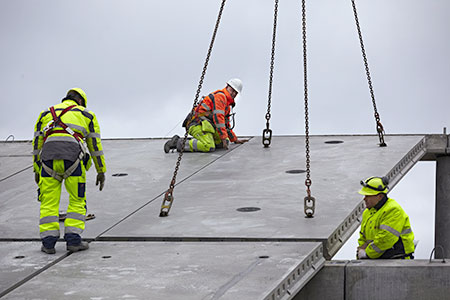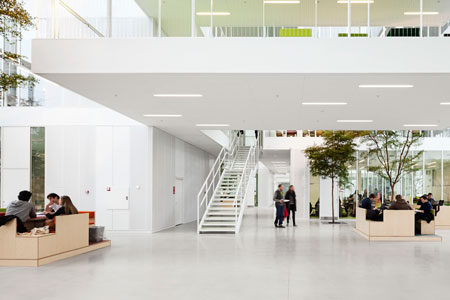The super-light concrete deck is emerging as the new floor partition element in construction. The decks offer concrete constructions new expressions while improving building sound insulation and fire safety.
In Copenhagen, NCC construction and property development company is currently building new blocks of flats. Halfway through the project, the contractor has decided to use the new super-light concrete decks—also called SL-Decks—as floor partition material, instead of the conventional concrete decks.
It is highly unusual to make such radical changes this late in the planning and design of a construction project. However, the decision has been made on the basis of thorough analyses that indicate a number of advantages of switching to SL-Decks:
"At Krøyers Plads, we are building a number of geometrically exciting buildings. The SL-Decks simplify the construction of the base structures because we are able to reduce the number of building components. We get fewer on-site procedures and can save many man-hours, because the SL-Decks offer prefabricated solutions to the problems. On delivery, the decks feature for example edge reinforcement and sockets for hand rails which normally have to be installed at the construction site. Now we don't have to spend time on that. Furthermore, it means that safety is high at the site from day one," explains Klaus Iversen, Senior Project Manager in the Concrete & Civil Works' section of NCC Construction Danmark. He adds that even though SL-Decks are more expensive than standard decks, the extra investment is returned because the time spent at the construction site will be significantly reduced:
"Our analyses show that we will be able to reduce our floor area construction processes by 31 per cent."

Roofing panels of lightweight concrete are mounted on Gammel Hellerup Gymnasium’s new building for leisure and cultural activities. The building was designed by BIG Bjarke Ingels Group.
SL-Decks offer major advantages
The SL-Decks are based on the invention of a new super-light concrete structure technology—invented by Professor Kristian Hertz from DTU Civil Engineering. He has combined well-known materials in a new way to enable replacing traditional, expensive and energy-intensive concrete and steel structures with less expensive and more eco-friendly deck components. The principle behind the new concrete technology is to produce a strong concrete skeleton, surrounded on one or more sides by lightweight concrete. The strong concrete carries the load and can be placed precisely where it benefits the structure the most.
Tests show that SL-Decks hold a number of additional benefits compared to traditional concrete decks—for example, SL-Decks outperform sound insulation in standard decks by a factor of four. That means less noise between two floors. In addition, SL-Deck can withstand fire four times as long as other concrete decks, i.e. the time it takes before the element loses its load-bearing capacity.
Greater architectural freedom
The SL-Deck also offers new design options within concrete construction as it enables fixed end deck support at walls. This means that a reinforcement is embedded in the top of the decks when they are installed in the building. In this way, it is possible to achieve spans up to 75 per cent longer than when using conventional concrete decks. The long SL-Deck spans do not require additional support—for example from pillars and walls. In addition, beams can be embedded in the deck to prevent them from taking up space under them.
"It means that floor partitions can be thinner, which boosts light incidence in a building, enabling light to penetrate further into the building. And if we are talking about a high-rise, the thinner partitions can even mean that we can build 21 floors instead of only 20, but still maintain the same building height," says architect Finn Nørkjær, partner at BIG Bjarke Ingels Group, and adds:
"This also entails geometric freedom which means that we have the option of designing more than just squares. The SL-Decks enable us to make round or 17-square concrete buildings."
Green profile
Kristian Hertz' invention of combining the strong and lightweight concrete means that you use up to 50 per cent fewer materials. Concrete is known to impact CO2 accounts negatively, and it is estimated that 10-15 per cent of the world's carbon dioxide emissions come from building structures. The reduced materials consumption from using the SL-Decks thus reduces the emissions.
The spin-out Abeo A/S
In 2010, Kristian Hertz' invention produced the spin-out company Abeo A/S that developed the SL-Decks.

The first building where SL-Decks were used was Building 324—a new teaching and research building at DTU Lyngby Campus, which was completed in 2012. Here, the decks were used as suspended walkways.
Since then, the interest for the SL-Deck has spread, which has not gone unnoticed by CEO of Abeo, Hans Terney Rasmussen:
"There are many projects in the pipeline in both the Danish public and private sector, where the SL-Deck is in play. But we are also seeing an interest from abroad, having received inquiries from Sweden, Germany, Australia, USA, Canada and Malaysia, among others," says Hans Terney Rasmussen.
He explains that the SL-Deck has been developed in close collaboration with architects and contractors, which has resulted in an exchange of knowledge rarely seen in the construction sector. Abeo therefore has a unique product.